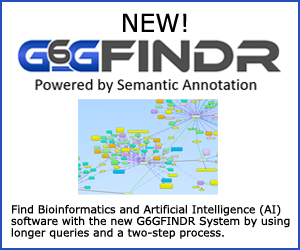NetworkAnalyzer
Category Cross-Omics>Pathway Analysis/Gene Regulatory Networks/Tools
Abstract NetworkAnalyzer is a versatile and user-friendly tool for the analysis of biological and other networks.
This plug-in is well integrated into Cytoscape (see G6G Abstract Number 20092) and computes a comprehensive list of ‘simple and complex topology parameters’ using efficient graph algorithms.
It incorporates useful visualization settings to display and export the resulting distributions and adds node attributes for the results.
NetworkAnalyzer efficiently computes a large number of ‘topological network parameters’ for directed and undirected networks loaded into Cytoscape. The user can decide whether ‘directed edges’ should be treated as undirected for the analysis.
The computed simple and complex topology parameters are represented as single values and distributions, respectively.
‘Simple parameters’ are the number of nodes, edges, self-loops, and connected components, the average number of neighbors, the network diameter, radius, density, centralization, heterogeneity, and clustering coefficient, the number of shortest paths, and the characteristic path length.
‘Complex parameters’ are distributions of node degrees, neighborhood connectivities, average clustering coefficients, topological coefficients, shortest path lengths, and shared neighbors of two nodes.
NetworkAnalyzer utilizes the free Java libraries JFreeChart -
(JFreeChart is a free 100% Java ‘chart library’ that makes it easy for developers to display professional quality charts in their applications); and
Batik - [Batik is a Java-based toolkit for applications or applets that want to use images in the Scalable Vector Graphics (SVG) format for various purposes, such as display, generation or manipulation] to display the distributions as histograms or ‘scatter plots’ and to export them as chart images in the formats (JPG/PNG/SVG) or as tables in plain text files.
Details on the formal definitions of all topological parameters are given in the online ‘Help page’ for NetworkAnalyzer.
To ensure the validity of the calculations performed by NetworkAnalyzer, the computed parameters were compared with those obtained from Pajek - [Pajek (Slovene word for Spider) is a program, for Windows, for the analysis and visualization of large networks], TopNet, and using the Python graph library NetworkX.
NetworkAnalyzer features/capabilities --
While the majority of the topological parameters included in NetworkAnalyzer is already well known and frequently used in the literature, the manufacturers plug-in additionally computes some novel network properties.
In particular, the manufacturer has extended the original definition of neighborhood connectivity [Maslov S, Sneppen K. Specificity and stability in topology of protein networks. Science (2002) 296:910–913] to directed networks by introducing three (3) types of related connectivity parameters.
NetworkAnalyzer is also capable of enumerating the shared neighbors of all node pairs in a network.
Further unique features of NetworkAnalyzer comprise various ‘visual settings’ of the obtained diagrams.
The user has the option of switching between histogram or scatter plot of the computed distributions and between linear or logarithmic scales for any of the two displayed diagram axes.
Gridlines can be enabled or disabled and a ‘power law’ can be fitted to resultant distributions.
Additionally, the title of the chart diagram, the labels of the axes, and the colors of the scatter points and gridlines can be configured.
Topology parameters computed for network nodes are stored as ‘node attributes’ in the Cytoscape data structure. Thus, users can easily apply the ‘visual mapping’ settings of Cytoscape to highlight any parameter on the screen (see the manufacturer’s online tutorial).
For example, the clustering coefficient may be visualized proportional to the node size, and the node color may be related to its degree.
Another useful application of NetworkAnalyzer is the selection of nodes based on any of the ‘calculated attributes’. This enables Cytoscape users to examine, for instance, ‘structural perturbations’ in a network caused by the removal of nodes with high degrees.
In NetworkAnalyzer, the complete set of simple and complex parameters is referred to as ‘network statistics’. Once calculated and displayed the network statistics can be saved into and reloaded from a text file in order to avoid re-computation.
The comparison of multiple network topologies can easily be achieved by the ‘parallel inspection’ of the computed statistics for different networks.
Optional user settings can be stored and reloaded. Users can customize the appearance of the results by choosing between two alternative dialog interfaces, a compact interface and an expandable interface.
Aside from parameter computations, NetworkAnalyzer offers a useful set of ‘network modifications’ and ‘supports the construction’ of the intersection, union, and difference of two networks, the extraction of connected components as new separate networks, and the removal of self-loops.
NetworkAnalyzer Help and documentation --
Definitions of the listed parameters are available on the manufacturer's extensive Help page. You can also download the Help page for offline reading.
The manufacturers have also created a step-by-step tutorial on how to use NetworkAnalyzer for spotting ‘hub nodes’ in a network.
System Requirements
Contact manufacturer.
Manufacturer
- Max-Planck-Institut für Informatik
- Computational Biology and Applied Algorithmics
- Campus E1 4
- 66123 Saarbrücken, Germany
Manufacturer Web Site Max-Planck-Institut für Informatik
Price Contact manufacturer.
G6G Abstract Number 20574
G6G Manufacturer Number 104039







